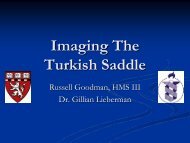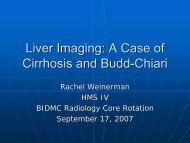The Basics of MRI: T1 vs. T2
The Basics of MRI: T1 vs. T2
The Basics of MRI: T1 vs. T2
You also want an ePaper? Increase the reach of your titles
YUMPU automatically turns print PDFs into web optimized ePapers that Google loves.
Frank Minja, HMS III<br />
Gillian Lieberman, MD<br />
<strong>T1</strong> relaxation<br />
• <strong>The</strong> parallel and anti-parallel magnetic moments will fall onto the<br />
transverse plane when pulsed by a 90 degree RF<br />
• <strong>The</strong> net magnetic moment aligned with the External Magnetic Field<br />
• Enter a 90 degree RF pulse<br />
• <strong>The</strong> transverse plane is a high energy state<br />
• <strong>The</strong> Magnetic moments will ‘relax’ back to the vertical plane - low<br />
energy state<br />
• <strong>T1</strong> Relaxation back to the vertical plane<br />
• <strong>The</strong> energy (radiowaves) emitted during this relaxation gives the <strong>T1</strong><br />
signal<br />
• <strong>T1</strong> relaxation curve<br />
• <strong>The</strong> net magnetic moment re-aligned with the External Field<br />
7
















